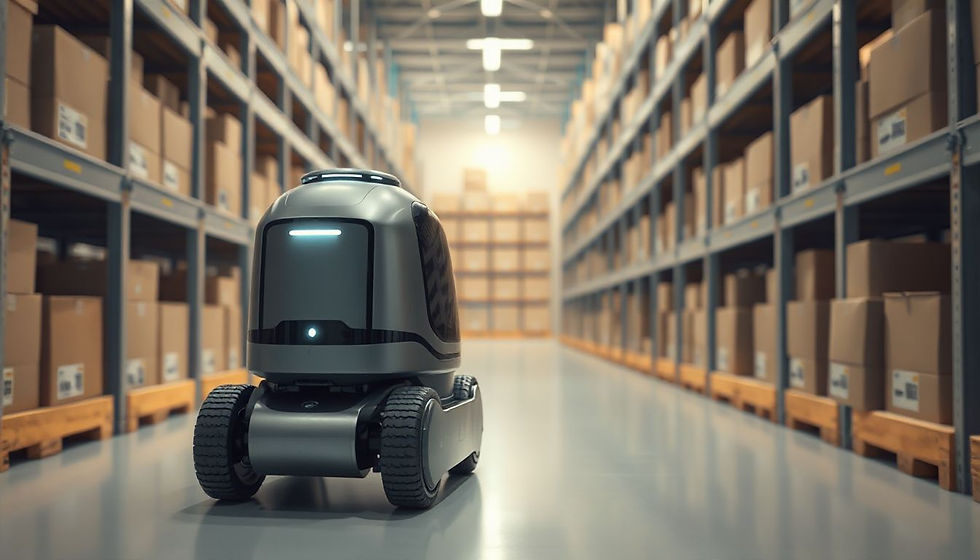What are Autonomous Robots - An Introduction to Autonomous Mobile Robots
- conveyorsystems965
- Aug 25
- 3 min read
Updated: 10 hours ago
When we hear the phrase robotic, we frequently think of machines doing paintings for us, perhaps something out of a sci-fi movie. But in real lifestyles, robots have emerged as quite commonplace, mainly in factories and warehouses. The actual game-changer, though, is autonomous robots—smart machines that may do obligations on their very own, without someone controlling them each step of the way.
These styles of robots are built to think and act independently. That approach allows they to make decisions in real time based on their surroundings. Because of this, they’re perfect for taking on jobs that are dull, dirty, or maybe risky, releasing human beings to attention on extra interesting and treasured paintings.

Over the beyond 15– many years, we’ve visible robots applied in all varieties of techniques. Think of robots with cameras that assist in looking at hard-to-achieve areas, or simple machines that do repetitive jobs in factories. These are beneficial systems, but they may no longer be truly self-sufficient.
For example, Automated Guided Vehicles (AGVs) are utilized in warehouses to transport substances around. Drones can help in seek and rescue after failures. Underwater robots have even explored shipwrecks deep within the ocean. These are wonderful, no question; however, the maximum of them nonetheless observe pre-set instructions or need human guidance.
Here’s what things can get a hint tough: some agencies call any robot device “independent” or powered with the resource of “AI” to make it sound more high-tech. But just due to the reality that a robotic action does something beneficial doesn’t mean it is sincerely impartial.
So what is an autonomous robot?
A sincerely impartial robot does not certainly observe instructions. It can recognize its surroundings, make its non-public judgments, and adapt to adjustments without relying on a person to inform it what to do.
Robots and Autonomous Systems
A self-maintaining device is capable of conducting dreams in a converting environment, collecting facts, and running for prolonged intervals of time without human intervention. Autonomous Mobile Robots (AMRs) are an excellent example of robotics and autonomous systems in warehouse environments. Automated robotic systems can help warehouses in numerous ways.
The Worst Example of an Autonomous Robot
Often, the machines on a vehicle assembly line are mistakenly called robots. Although they'll seem like robots, they may certainly be extra much like milling machines managed through computer systems, referred to as CNC machines.
Unlike self-keeping robots, these business devices are pre-programmed to carry out repeated actions. They are not able to react.
For example, what could appear if one of these so-called robotic systems responsible for installing spare tires inside the trunk of an automobile encountered a random scenario wherein the trunk shut? Would the “robot” know now not to install the tire?
Probably no longer now. Instead, this machine should preserve sporting out its programmed project and might most possibly wreck the tire well through the trunk lid. If the system were a real self-sustaining robot, it would not deploy the tire and could realize that the trunk would become closed.

How AMRs Differ from AGVs
Navigational Methods
AGVs often tour in defined pathways, which include magnetic strips or painted traces. They cannot speedily alternate their path. In contrast, AMRs navigate dynamically the usage of maps and sensors. They can detect new obstacles and discover a trade course around them without being prevented. The ability to conform is a huge gain for busy areas.
Infrastructure Requirements
Setting up AGVs often requires modifications to your facilities. You may additionally
need to position wires on the floor or use unique markers. Large adjustments are rarely required for AMRs. They might also commonly carry out inner your current setup, charting the gap as they go. This makes them a lousy lot less difficult to combine into your agency
Operational Flexibility
AMRs are constructed for complicated, changing environments. They can reroute if someone or a forklift blocks their route. They also paint accurately near human beings, slowing down or stopping when wished. AGVs have far less of this capability to adapt. Their fixed routes restrict how they interact with a dynamic environment.
Actuation
Humans have actuators referred to as muscle corporations. They are available in many forms and sizes and serve an expansion of purposes, from grabbing a cup of espresso to beating our hearts and pumping blood. Robots can also have many kinds of actuators, with a motor at the center of each. Whether it's a wheel, a linear actuator, or a hydraulic ram, a motor is constantly reworking electricity into motion.
Our whole fleet of independent mobile robots may additionally see (using LiDAR and imaginative and prescient technology), make choices, and drift using wheels. They can paint in any region of your warehouse and supply stuff around, lowering wasted on foot time for personnel and greatly increasing productivity and cycle times.
Interested? Let’s talk!



Comments